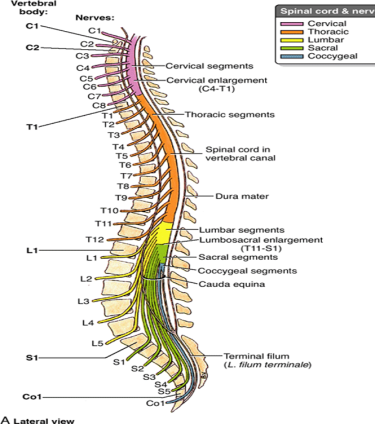Spine is the central axis of our body that runs from the head to the pelvis and it is made up of a chain of bones (vertebrae) connected to each other by discs and joints. This strong structure acts as an anchor to the trunk and limbs and provides stability to our upright posture while allowing normal movements at the same time.
Apart from providing structural support to out trunk, the spine acts as a strong protective covering for the main nerve (Spinal cord) that carries the signals (stimuli) to and from the brain to the rest of our body. The nerve roots are like cables arising from the spinal cord that exit the spine, one at each level, and run into the arms, around the trunk and the legs, on both sides, supplying all the structures of the body, carrying signals – to and from the brain.
So the functions of the Spine are:
As humans evolved to walk on two legs, the orientation of the spine changed from horizontal to vertical position and that makes the human spine unique, with its own unique problems.
The symptoms and signs that indicate possible serious causes for back pain are called the “red flag” signs, which the doctors look for during examination, indicating that there is an immediate risk of further harm to the patient, needing further evaluation, in the form of spine imaging and/or blood tests to find the cause of the pain. conditions also which could be the cause for the spinal pain. An osteoporotic fracture, spinal infections like tuberculosis, a tumour that has spread to the spine are some examples. Sometimes the pain could be a warning sign of an imminent vertebral collapse or neurological impairment.



The structures in the spine can be affected by various disorders and lead to the various symptoms related to spine. The common symptoms include back or neck pain, pain radiating down the arms or legs, numbness or weakness in the limbs, limitation of ability to walk and result in inability to do other daily routine activities of life. Less commonly, there can be paralysis of the limbs, severe numbness and loss of bowel and bladder control in situations where there is a significant compression of neural structures in the spine.
The spine can get affected by disorders at all ages from the time of development of fetus in the womb to the old age. The most common disorder affecting the spine is the age related wear and tear changes, known as “degeneration” or “spondylosis“. These wear and tear changes start in the discs of the spine and gradually affect the joints and the bones and can lead to various symptoms like back or neck pain, sciatica, weakness of limb muscles, numbness and deformity in the spine.
The spine can get affected by formation defects during development in the womb leading to spinal deformity. Such deformity in the spine may manifest as an abnormal swelling at birth or as a progressive hump back as the child grows. “Scoliosis” or “kyphosis” are the usual terms used to describe these deformities. Scoliosis may also develop in the growing children, that may go unnoticed till it becomes significantly large. “Spondylolisthesis” is a disorder that affects the lower spine and starts in the growing children, where there is a forward slipping of one vertebra over the other, causing back pain and deformity as well as radiating pain into the legs due to compression of the nerve roots at that level.
Traumatic injury to the spine can cause fractures or dislocation in the spine and injure the neural structures in the spine that can lead to devastating consequences like paraplegia (paralysis of both lower limbs) or quadriplegia (paralysis of all four limbs) including loss of bladder and bowel control. Minor injuries can lead to chronic pain, neurological symptoms and disability.
The spine can get affected by bacterial infections at any age, most commonly tuberculosis in India. Other bacterial infections are often encountered though not as common as tuberculosis. Infection destroys the bones and discs in the spine and can make it unstable leading to pain and nerve compression. It may also result in spinal deformity.
Spine is a common location for tumours/cancers that spread from other organs like lungs, breast, gut, liver, thyroid, prostrate gland etc. especially in the older age group. Less commonly, tumours can primarily arise in the spine itself, at any age. Spinal tumours cause pain and disability and neurological symptoms due to compression on the nerves. It is imperative that these are detected at the earliest, to prevent serious consequences and to be able to deal with them in a better way.
Osteoporosis is a disease that occurs in old age, especially in ladies after the menopause. The bones become more porous and weak and can crumble easily leading to fractures. The spine is the most common site for osteoporosis related fractures and deformity, leading to significant disability and limitation of quality of life. Osteoporosis can progress silently, without any symptoms until it results in a fracture. It can be detected early by simple screening tests like DEXA scan.
Posture related spinal problems are very common nowadays due the modern lifestyle. Sitting in bad posture on desk jobs or overuse of mobile phones with a forward bent neck puts undue strain on the spinal muscles and leads to significant pain and disability. Lack of exercise and reduced sleeping hours makes the situation worse.
Understanding the Spine and common spinal disorders can help you to take better care of your spine and prevent serious spine related disability. There are a lot of misconceptions regarding the spinal disorders that add to the problem and appropriate education and awareness can prevent significant amount of distress.!

With years of experience in spine surgery, Dr Phani Kiran S, Senior Consultant Spine Surgeon will assess you and suggest the treatment option that is right for you.
We at Medspine clinics, understand the importance of educating all our patients about the spinal problems and the most effective ways to take care of their spine.
The Ortho Clinic: Monday, Wednesday, Friday, Saturday.
Ojas Health: Tuesday, Thursday
© Copyright 2024 MedSpine. All Rights Reserved. Build with 🤍 by Digital GYB
WhatsApp us